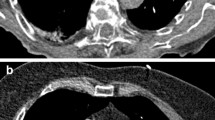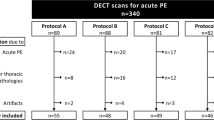Abstract
Objectives
To analyse 80-kVp 16-MDCT in patients with clinically suspected pulmonary embolism (PE) and diminished renal function after a reduction in dose of contrast medium (CM) from 200 to 150 mg I/kg.
Methods
Fifty patients with suspected PE and glomerular filtration rate (GFR) less than 50 mL/min underwent 80-kVp 16-MDCT with 150 mg I/kg. Mean density/image noise (1 standard deviation) was measured in a region of interest in the left pulmonary artery (LPA) and a lower lobe segmental artery (LLSA), and the contrast-to-noise ratio (CNR) was calculated. The values of LPA and LLSA were averaged.
Results
Median values/2.5–97.5 percentiles were: age 84/67–96 years, weight 65/43–84 kg, GFR 36/21–45 mL/min, CM dose 9.6/6.4–12 g of iodine, PA density 353/164–495 HU and CNR 11/4.4–20. PE incidence was 16%, and 8% and 12% of the examinations were regarded suboptimal by observer 1 and 2, respectively. Density/CNR values were within ranges reported for common 120-kVp MDCT protocols. None of 32 patients with plasma-creatinine follow-up within 1 week experienced a rise of more than 44.2 μmol/L and none of 50 patients had oliguria/anuria or dialysis. None of 40 patients with a negative CT/no anticoagulation had thromboembolism during follow-up.
Conclusion
80-kVp MDCT combined with individualised ultralow CM doses may provide satisfactory diagnostic quality, which should be to the benefit of patients at risk of contrast medium-induced nephropathy.


Similar content being viewed by others
References
Remy-Jardin M, Pistolesi M, Goodman LR, Gefter WB, Gottschalk A, Mayo JR, Sostman HD (2007) Management of suspected acute pulmonary embolism in the era of CT angiography: a statement from the Fleischner Society. Radiology 245:315–329
Mehran R, Nikolsky E (2006) Contrast-induced nephropathy: definition, epidemiology, and patients at risk. Kidney Int Suppl 69:S11–S15
PIOPED (1990) Value of the ventilation/perfusion scan in acute pulmonary embolism. Results of the prospective investigation of pulmonary embolism diagnosis (PIOPED). The PIOPED Investigators. JAMA 263:2753–2759
Sostman HD, Stein PD, Gottschalk A, Matta F, Hull R, Goodman L (2008) Acute pulmonary embolism: sensitivity and specificity of ventilation-perfusion scintigraphy in PIOPED II study. Radiology 246:941–946
Johnson PT, Naidich D, Fishman EK (2007) MDCT for suspected pulmonary embolism: multi-institutional survey of 16-MDCT data acquisition protocols. Emerg Radiol 13:243–249
Sigal-Cinqualbre AB, Hennequin R, Abada HT, Chen X, Paul JF (2004) Low-kilovoltage multi-detector row chest CT in adults: feasibility and effect on image quality and iodine dose. Radiology 231:169–174
Waaijer A, Prokop M, Velthuis BK, Bakker CJ, de Kort GA, van Leeuwen MS (2007) Circle of Willis at CT angiography: dose reduction and image quality-reducing tube voltage and increasing tube current settings. Radiology 242:832–839
Kalender WA, Deak P, Kellermeier M, van Straten M, Vollmar SV (2009) Application- and patient size-dependent optimization of x-ray spectra for CT. Med Phys 36:993–1007
Holmquist F, Hansson K, Pasquariello F, Bjork J, Nyman U (2009) Minimizing contrast medium doses to diagnose pulmonary embolism with 80-kVp multidetector computed tomography in azotemic patients. Acta Radiol 50:181–193
Boone JM, Geraghty EM, Seibert JA, Wootton-Gorges SL (2003) Dose reduction in pediatric CT: a rational approach. Radiology 228:352–360
Huda W, Scalzetti EM, Levin G (2000) Technique factors and image quality as functions of patient weight at abdominal CT. Radiology 217:430–435
Nagel HD, Galanski M, Hidajar N, Maier W, Schmidt T (2002) Radiation exposure in computed tomography. Fundamentals, influencing parameters, dose assessment, optimization, scanner data, terminology. CTB, Hamburg
National Kidney Foundation (2002) K/DOQI clinical practice guidelines for chronic kidney disease: evaluation, classification, and stratification. Part 4. Definition and classification of stages of chronic kidney disease. Am J Kidney Dis 39:S46–S75
Nyman U, Björk J, Sterner G, Bäck SE, Carlson J, Lindström V, Bakoush O, Grubb A (2006) Standardization of p-creatinine assays and use of lean body mass allow improved prediction of calculated glomerular filtration rate in adults: a new equation. Scand J Clin Lab Invest 66:451–468
Nyman U, Ahl TL, Kristiansson M, Nilsson L, Wettemark S (2005) Patient-circumference-adapted dose regulation in body computed tomography. A practical and flexible formula. Acta Radiol 46:396–406
New PF, Aronow S (1976) Attenuation measurements of whole blood and blood fractions in computed tomography. Radiology 121:635–640
Norman D, Price D, Boyd D, Fishman R, Newton TH (1977) Quantitative aspects of computed tomography of the blood and cerebrospinal fluid. Radiology 123:335–338
Huda W, Ogden KM, Khorasani MR (2008) Converting dose-length product to effective dose at CT. Radiology 248:995–1003
Altman DG (1991) Practical statistics to medical research. Chapman and Hall, London
Jones SE, Wittram C (2005) The indeterminate CT pulmonary angiogram: imaging characteristics and patient clinical outcome. Radiology 237:329–337
Laskey WK, Jenkins C, Selzer F, Marroquin OC, Wilensky RL, Glaser R, Cohen HA, Holmes DR Jr (2007) Volume-to-creatinine clearance ratio: a pharmacokinetically based risk factor for prediction of early creatinine increase after percutaneous coronary intervention. J Am Coll Cardiol 50:584–590
Nyman U, Almen T, Aspelin P, Hellström M, Kristiansson M, Sterner G (2005) Contrast-medium-Induced nephropathy correlated to the ratio between dose in gram iodine and estimated GFR in ml/min. Acta Radiol 46:830–842
Nyman U, Björk J, Aspelin P, Marenzi G (2008) Contrast medium dose-to-GFR ratio: a measure of systemic exposure to predict contrast-induced nephropathy after percutaneous coronary intervention. Acta Radiol 49:658–667
Bae KT, Mody GN, Balfe DM, Bhalla S, Gierada DS, Gutierrez FR, Menias CO, Woodard PK, Goo JM, Hildebolt CF (2005) CT depiction of pulmonary emboli: display window settings. Radiology 236:677–684
Bae KT, Tao C, Gurel S, Hong C, Zhu F, Gebke TA, Milite M, Hildebolt CF (2007) Effect of patient weight and scanning duration on contrast enhancement during pulmonary multidetector CT angiography. Radiology 242:582–589
Holmquist F, Nyman U (2006) Eighty-peak kilovoltage 16-channel multidetector computed tomography and reduced contrast-medium doses tailored to body weight to diagnose pulmonary embolism in azotaemic patients. Eur Radiol 16:1165–1176
Szucs-Farkas Z, Kurmann L, Strautz T, Patak MA, Vock P, Schindera ST (2008) Patient exposure and image quality of low-dose pulmonary computed tomography angiography: comparison of 100- and 80-kVp protocols. Invest Radiol 43:871–876
Szucs-Farkas Z, Strautz T, Kurmann L, Patak MA, Vock P, Schindera ST (2009) Does 80 kVp pulmonary CT angiography deliver sufficient image quality in patients weighing up to 100 kg. Eur Radiol 19(Suppl 1):S190
Awai K, Hiraishi K, Hori S (2004) Effect of contrast material injection duration and rate on aortic peak time and peak enhancement at dynamic CT involving injection protocol with dose tailored to patient weight. Radiology 230:142–150
Anderson DR, Kahn SR, Rodger MA, Kovacs MJ, Morris T, Hirsch A, Lang E, Stiell I, Kovacs G, Dreyer J, Dennie C, Cartier Y, Barnes D, Burton E, Pleasance S, Skedgel C, O’Rouke K, Wells PS (2007) Computed tomographic pulmonary angiography vs ventilation-perfusion lung scanning in patients with suspected pulmonary embolism: a randomized controlled trial. JAMA 298:2743–2753
Patel S, Kazerooni EA (2005) Helical CT for the evaluation of acute pulmonary embolism. AJR Am J Roentgenol 185:135–149
van Belle A, Buller HR, Huisman MV, Huisman PM, Kaasjager K, Kamphuisen PW, Kramer MH, Kruip MJ, Kwakkel-van Erp JM, Leebeek FW, Nijkeuter M, Prins MH, Sohne M, Tick LW (2006) Effectiveness of managing suspected pulmonary embolism using an algorithm combining clinical probability, D-dimer testing, and computed tomography. JAMA 295:172–179
Bae KT, Heiken JP, Brink JA (1998) Aortic and hepatic contrast medium enhancement at CT. Part II. Effect of reduced cardiac output in a porcine model. Radiology 207:657–662
Husmann L, Alkadhi H, Boehm T, Leschka S, Schepis T, Koepfli P, Desbiolles L, Marincek B, Kaufmann PA, Wildermuth S (2006) Influence of cardiac hemodynamic parameters on coronary artery opacification with 64-slice computed tomography. Eur Radiol 16:1111–1116
Schmidt C, Theilmeier G, Van Aken H, Korsmeier P, Wirtz SP, Berendes E, Hoffmeier A, Meissner A (2005) Comparison of electrical velocimetry and transoesophageal Doppler echocardiography for measuring stroke volume and cardiac output. Br J Anaesth 95:603–610
Suttner S, Schollhorn T, Boldt J, Mayer J, Rohm KD, Lang K, Piper SN (2006) Noninvasive assessment of cardiac output using thoracic electrical bioimpedance in hemodynamically stable and unstable patients after cardiac surgery: a comparison with pulmonary artery thermodilution. Intensive Care Med 32:2053–2058
Loud PA, Katz DS, Klippenstein DL, Shah RD, Grossman ZD (2000) Combined CT venography and pulmonary angiography in suspected thromboembolic disease: diagnostic accuracy for deep venous evaluation. AJR Am J Roentgenol 174:61–65
Kalra M, Brady T (2006) Care Dose4D. New technique for radiation dose reduction. Somatom Sessions 19: 28–31. Available at http://www.medical.siemens.com/siemens/en_INT/gg_ct_FBAs/files/somatomworld/somatom_sessions/SOMATOM_Sessions_19.pdf. Accessed 27 Sept 2009
Stein PD, Fowler SE, Goodman LR, Gottschalk A, Hales CA, Hull RD, Leeper KV Jr, Popovich J Jr, Quinn DA, Sos TA, Sostman HD, Tapson VF, Wakefield TW, Weg JG, Woodard PK (2006) Multidetector computed tomography for acute pulmonary embolism. N Engl J Med 354:2317–2327
Gottsäter A, Berg A, Centergård J, Frennby B, Nirhov N, Nyman U (2001) Clinically suspected pulmonary embolism: is it safe to withhold anticoagulation after a negative spiral CT? Eur Radiol 11:65–72
Barrett BJ, Katzberg RW, Thomsen HS, Chen N, Sahani D, Soulez G, Heiken JP, Lepanto L, Ni ZH, Nelson R (2006) Contrast-induced nephropathy in patients with chronic kidney disease undergoing computed tomography: a double-blind comparison of iodixanol and iopamidol. Invest Radiol 41:815–821
Becker CR, Reiser MF (2005) Use of iso-osmolar nonionic dimeric contrast media in multidetector row computed tomography angiography for patients with renal impairment. Invest Radiol 40:672–675
Kuhn MJ, Chen N, Sahani DV, Reimer D, van Beek EJ, Heiken JP, So GJ (2008) The PREDICT study: a randomized double-blind comparison of contrast-induced nephropathy after low- or isoosmolar contrast agent exposure. AJR Am J Roentgenol 191:151–157
Nguyen SA, Suranyi P, Ravenel JG, Randall PK, Romano PB, Strom KA, Costello P, Schoepf UJ (2008) Iso-osmolality versus low-osmolality iodinated contrast medium at intravenous contrast-enhanced CT: effect on kidney function. Radiology 248:97–105
Thomsen HS, Morcos SK, Erley CM, Grazioli L, Bonomo L, Ni Z, Romano L (2008) The ACTIVE Trial: Comparison on the effects on renal function of iomeprol-400 and iodixanol-320 in patients with chronic kidney disease undergoing abdominal computed tomography. Invest Radiol 43:170–178
Bruce D, Loud PA, Klippenstein DL, Grossman ZD, Katz DS (2001) Combined CT venography and pulmonary angiography: how much venous enhancement is routinely obtained? AJR Am J Roentgenol 176:1281–1285
Righini M, Le Gal G, Aujesky D, Roy PM, Sanchez O, Verschuren F, Rutschmann O, Nonent M, Cornuz J, Thys F, Le Manach CP, Revel MP, Poletti PA, Meyer G, Mottier D, Perneger T, Bounameaux H, Perrier A (2008) Diagnosis of pulmonary embolism by multidetector CT alone or combined with venous ultrasonography of the leg: a randomised non-inferiority trial. Lancet 371:1343–1352
Acknowledgements
Radiographers Lars Nilsson, Staffan Wettemark and Anna Johansson for supervising the performance of the computed tomography examinations. Jonas Björk, Ph.D., Competence Centre for Clinical Research, University of Lund, University Hospital, Lund, Sweden, for statistical advice. Librarian Elisabeth Sassersson, Lasarettet Trelleborg, for excellent service regarding literature references.
Author information
Authors and Affiliations
Corresponding author
Additional information
Ulf Nyman was part of an expert group of The Swedish Council on Technology Assessment of Health Care and The National Board of Health and Welfare establishing evidenced-based national guidelines regarding diagnosis of pulmonary embolism.
Rights and permissions
About this article
Cite this article
Kristiansson, M., Holmquist, F. & Nyman, U. Ultralow contrast medium doses at CT to diagnose pulmonary embolism in patients with moderate to severe renal impairment: a feasibility study. Eur Radiol 20, 1321–1330 (2010). https://doi.org/10.1007/s00330-009-1691-0
Received:
Revised:
Accepted:
Published:
Issue Date:
DOI: https://doi.org/10.1007/s00330-009-1691-0




